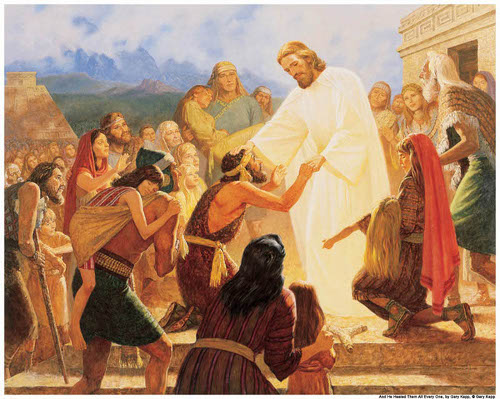
(by Gary Kapp)
Sat 4 Oct 2014, 7 Reed (SR)
©2014 by John P. Pratt. All rights Reserved.
| 1. Christ Appears to Nephites |
| 2. Loaves, Fishes & Lord's Supper |
| 3. Proposed Dates |
| 3.1 Nephite Events |
| 3.2 "End" of Nephite Year |
| 3.3 Galilean Events |
| 3.4 Merc Century |
| 4. Conclusion |
| Notes |
The Book of Mormon testifies of an extremely important three-day appearance of Jesus Christ shortly after his resurrection and ascension to a people who lived in the Americas called the Nephites. He taught them about baptism and the sacrament and gave the Sermon on the Mount almost exactly as found in the Bible. Then He healed all who were brought to Him and the multitude were fed bread and wine. On the second day, bread and wine for the sacrament of the Lord's Supper were miraculously produced for the attending multitude.
All four Gospels describe the miracle of feeding the 5,000 with loaves and fishes. The Book of John adds that on the following day Jesus taught about the sacrament, claiming that those who eat His flesh and drink His blood will inherit eternal life.
This article reviews those events and then proposes precise dates of just when they occurred.
The Book of Mormon tells of the appearance of Jesus Christ to the Nephites during the year of his resurrection and ascension (3 Nephi 11-26). Let's briefly review that account.
A multitude of survivors of the great destruction among the Nephites at the time of the Crucifixion were gathered at a temple. They heard a voice three times from heaven. The third time they understood that it was Heavenly Father introducing His Son to them.
Jesus then descended from heaven. He taught them about baptism and gave twelve men the power to baptize. He then delivered the Sermon on the Mount almost exactly as recorded in Matthew 5-7 (3 Nephi 12-14). He then added two more chapters of prophecy and gospel teachings (3 Nephi 15-16).
 |
The multitude wanted him to tarry, so He then healed all of those who needed healing. After that He called for their little children and blessed them one by one (3 Nephi 17).
Then he asked his twelve disciples to bring some bread and wine. We are not told how much they brought, but He gave it to the multitude and they were filled. He then introduced the idea of the sacrament of the Lord's Supper and explained that one among them would be ordained to administer that ordinance to them. Finally He touched each of the twelve disciples and gave them power to give the Holy Ghost. Then He ascended again into heaven (3 Nephi 18).
It was still before dark on that first day (3 Nephi 19:2) and the multitude immediately dispersed to tell others of His promised return the next day. On the morrow, the twelve broke the multitude into groups and repeated Christ's words from the previous day. Then the twelve were baptized. The Holy Ghost fell upon them, they were encircled with fire, and the Jesus appeared and stood in their midst.
After powerful prayer, the Lord then more formally held the ordinance of the Sacrament of the Lord's Supper. This time it is emphasized that no bread nor wine at all was brought and yet again the multitude ate and drank. Then He went on to explain prophecies of Isaiah that if the Gentiles do not repent after the great blessings they would have received in our day, that they would be trodden down and torn to pieces (3 Nephi 20). Later he expounded more on Isaiah, quoted the last two chapters of Malachi, and finally He "did expound all things unto them" (3 Nephi 26:1). We are told his visit filled three days (3 Nephi 26:13), but the division between the second and third day is not made clear.
Before attempting to determine the date of this appearance to the Nephites, let us consider a similar, if less impressive, occurrence with the Galileans during His lifetime.
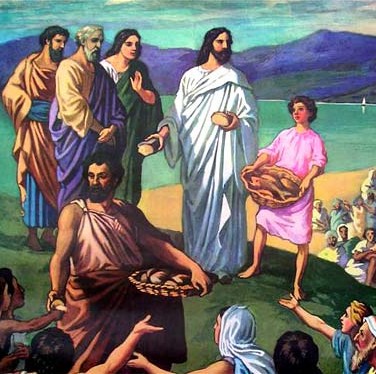 |
The only food found was five loaves and two fishes. Jesus multiplied the food so that everyone ate all they wanted and twelve baskets of food were left over. That evening, His disciples rowed across the sea to the west side while He left them to pray. He later came walking across the sea, and after Peter had tried that also (Mat. 14:29), He joined them in the boat.
The next day (John 6:22) a new group had heard about the miracle of the loaves and fishes. But the sermon on the second day was very different and tended to drive all the freeloaders away. After talking about manna, the bread from heaven at the time of Moses, Jesus told them, "I am the living bread which came down from heaven ... Whoso eateth my flesh and drinketh my blood, hath eternal life;" (John 6:51, 54) Even his disciples said that was a "hard saying" (John 6:60).
Even though that sermon is often thought of as simply a means to thin out those looking only for a free lunch, there is an important feature of that sermon which is often overlooked. It was given about a year before the Last Supper, where it is usually assumed that Jesus first introduced the sacrament of the Lord's Supper. But this Galilean sermon is apparently where the concept was first explained, even if in a harsh manner.
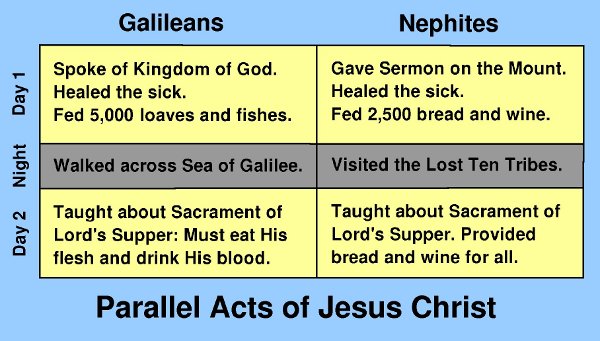 |
It is this Galilean sacrament sermon which links this event with the sacrament sermon given to the Nephites. In fact, there are three links: 1) multiplication of the food, 2) a strange, even miraculous, trip during the following night, and 3) a sacrament sermon the following day. These details are summarized in Table 1.
Now let us turn first to the question of dating the appearance of Jesus Christ to the Nephites, and then compare the dates to proposed dates for the miracle of feeding the 5,000 and the subsequent sermon.
What was the date of the appearance of Jesus Christ to the Nephites? There are several clues given in the Book of Mormon account. The most important quote, which appears to tell us the time of the visit, has actually led to a lot of confusion:
"And it came to pass that in the ending of the thirty and fourth year, behold, I will show unto you that the people of Nephi who were spared, and also those who had been called Lamanites, who had been spared, did have great favors shown unto them, and great blessings poured out upon their heads, insomuch that soon after the ascension of Christ into heaven he did truly manifest himself unto them" (3 Nephi 10:18).
This quote has caused much confusion, even though to me it now appears to be an attempt at clarity and precision. On the one hand, it says that the appearance of Christ was "shortly after" His Ascension, which seems to refer to the event only 40 days after the Resurrection (Acts 1:3). On the other hand, it says "end of the year" which sounds like nearly a full year after the Crucifixion, which had been on the fourth day of that year.
The issue is further complicated by the additional statement that survivors of the massive destruction at the Crucifixion were commenting on the huge changes that had taken place (3 Nephi 11:1). That gives the impression that the smoke was just clearing, and that the appearance of Christ was even sooner than forty days after the destruction.
Many people have asked me over the years why no proposed date for the most important event in the Book of Mormon has appeared in my articles. It has been because the date has eluded me, even with all of those clues. My article "Passover: Was It Symbolic of His Coming?" in 1994 in The Ensign proposed that Passover symbolized the coming of Jesus Christ in the Meridian of Time. It pointed out that His birth was on Passover, his public ministry began on Passover, and he came to the Spirit World on Passover. It seemed like his coming to both the Nephites and the Lost Tribes should also have been at Passover, but the dates did not fit.
All of my thoughts at that time (two decades ago), which had not been improved upon until last week, were succinctly summarized all in a footnote of that article. It is worth quoting here:
If the coming of Christ to the Nephites was near the end of their thirty-fourth year (see 3 Nephi 10:18), then that coming might also have been at Passover, in the year following the crucifixion, which had occurred early that year (see 3 Nephi 8:5). If so, it might explain why a great multitude was gathered at the temple (see 3 Nephi 11:1) as was customary at Passover, and also why he came to the lost tribes on the very same day that he came to the Nephites (see 3 Nephi 17:3-4).[1]
The problem with making this idea more than a footnote was twofold. First, part of the Savior's mission to the Nephites was to remind them that the law of Moses had been fulfilled and it was no longer necessary to keep the Passover ritual with all of its sacrifices, etc. It was a time to teach them about Christian ordinances like baptism and the sacrament of the Lord's Supper, which is just what He did. So with that in mind, it might have been counterproductive for Him to have arrived on Passover as if that were still a day to be celebrated.
Secondly, Passover in AD 34 was not on an especially holy day that jumped out as being correct. It fell on a Tuesday which was not holy on any other known sacred calendar. He came during the day because, after He left, people ran to tell others that He was coming the next day, and that occurred before the sunset. It just didn't seem like a Passover event, so that whole idea has remained a footnote until now.
There is, however, one detail about the law of Moses which changes everything. There is an "Easter Sunday" clearly indicated in the law of Moses. It was not designated as a holy day, but was only a day when a very minor offering was made. That was the Waving of the Sheaf of barley (Lev. 23:11), representing Christ as the firstfruits of the ground (1 Cor. 15:20). That is, it represented the Resurrection of Jesus Christ. That offering was made annually on the Sunday morning after Passover. That almost always coincides with the date of the Christian Easter.
What happened after the law of Moses was fulfilled is that the "Waving of the Sheaf" offering was promoted to be a major holy day, celebrating the Resurrection, when Christ overcame death for all mankind. It is what is generally called "Easter Sunday." On the other hand, Passover, which is still a holy day on sacred calendars, even as it was before the time of Moses, is no longer celebrated by most Christians.
It would make perfect sense for Christ to come at Easter to introduce and teach Christianity. Moreover, He still would be coming at Passover, but on the Sunday during Passover week, rather than on the initial feast day. Everything in the above quoted footnote would hold true had it suggested the Passover symbolism could be fulfilled by Christ coming during "Passover week" rather than restricting it to the "Passover day." It was exploring that possibility that led to this article.
The Sunday after Passover that year would have been 26 Mar 34 (all dates given are on our modern Gregorian Calendar), the sixth day of the seven days of Passover. That day was holy on several sacred calendars. It was Passover on the Uniform Jubilee Calendar (UJ). But just being Easter Sunday would be enough to initially recommend that day as a perfect day to teach Christianity.
Now let us turn to what is known about the Nephite Calendar, which provides strong corroboration for this proposal.
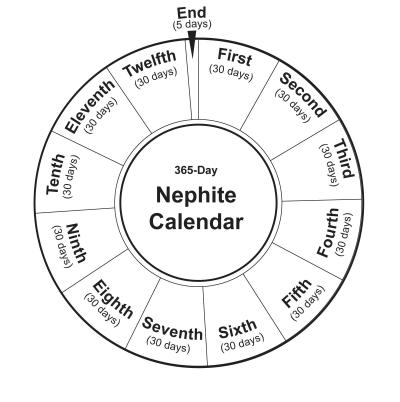 |
Evidence for a separate civil calendar is that they record that the sign given of the crucifixion of Christ occurred on the 4th day of the Nephite month (3 Nephi 8:5), whereas the New Testament makes it clear that it occurred on the 14th day of the Hebrew month when the Passover lamb is slain (John 18:28, 19:31). Therefore, the Nephite calendar being used was not the Hebrew Calendar.
A detailed model of the Nephite Calendar was proposed in 2004, based on the Egyptian civil calendar which was in use at the time the Nephite group left Jerusalem.[2] It has twelve months of thirty days, with five extra days at the end of the year. The illustration from that article is shown in Figure 1.
In that article it was shown that the length of the life of Jesus Christ exactly matches to the very day that indicated by other sacred calendars. We are told that the Nephites reset their calendar to begin a new era at the time the sign of the birth of Christ had been given (3 Nephi 2:8). If the first day of the first month of the first year corresponds to 6 Apr 1 BC, the day after the night on which the sign of His birth was given, then His death on Fri 1 Apr AD 33 would have fallen on the fourth day of the first month of the 34th exactly as recorded in the Book of Mormon (3 Nephi 8:5).
In that article precise dates for certain events are proposed based on that calendar. The speech of King Benjamin and the appearance of the angel to Amulek are examples. But no date was proposed for the appearance of Christ to the Nephites, the most important event in the entire book, because it was not clear what that date was.
After a decade, that proposed Nephite Calendar still appears to be correct and to have still been in use when Jesus Christ made his appearance to the Nephites during that 34th year. Dates can be calculated on that calendar, divided in to eras of Lehi, Judges, and Christ, on my Calendar Spreadsheet page by selecting "Nephite" in any of the column headers.
What led to the writing of this article was the realization that the author Mormon was being very precise when he said that Christ came "in the ending" of the 34th year. Earlier he had given the exact day of the destruction at the time of the Crucifixion. It makes sense that he would also be precise about the timing of the long-awaited coming of Jesus Christ to visit them.
Look again at the model of the Nephite Calendar in Figure 1. Note that the 5 days at the end of the year are called "End". If you were using that calendar, and if the Savior's appearance was during that 5-day period, how would you describe it? Mormon wrote that it happened "in the ending" of that year (3 Nephi 10:18), which seems to describe that situation perfectly. If it were in the twelfth month, then the author probably would have said that, even as he said the sign of the Crucifixion was in the first month on the fourth day. He did not use the vague terminology that the destruction was "in the beginning" of the year.
It is proposed that the three-day visit of the resurrected Jesus Christ to the Nephites occurred on the days Sat 25 Mar 34, Sun 26 Mar 34, and Mon 27 Mar 34. The first day was "End Transplanting" (UJ). The seems very significant because the Nephites began their journey of being transplanted to the Americas on the day "Begin Transplanting" (UJ). See my Religious Chronology page under "Lehi Departs" for other details about that date and other dates, such as Noah's Ark resting on the day "End Transplanting".
The second day was Easter Sunday as has been discussed in detail. The third day was the Last Day of Passover on the Hebrew Calendar, still a holy day even though the rites of the law of Moses were no longer celebrated. On the proposed Nephite Calendar those three days were 2 End, 3 End, and 4 End, fitting exactly into the five-day "ending" period most likely being referred to by Mormon. While that may not seem like "soon after the ascension of Christ" to us, it apparently did to Mormon, who was writing this account nearly four centuries after the visit of Jesus Christ occurred.
Now let us consider the timing of the events at the Sea of Galilee two years earlier.
The biggest clue to the timing of the Feeding of the 5,000 is that John tells us that the Passover was "nigh" (John 6:4). The word "nigh" means "near", but when used with time it is usually thought of as meaning "near in the future." Thus, it sounds as if the feeding of the 5,000 was shortly before Passover.
Let us consider the possibility that all John meant to say was that when he wrote his book many decades after the event, he could recall that the miracle took place sometime "near" Passover. The New English Bible translation is, "It was near the time of Passover."
Passover would most likely have been held during the seven days from Tue 13 Apr 32 to Mon 19 Apr 32. The first day of Passover, which is usually referred to simply as "Passover," was on a Tuesday which was not a holy day on any other calendar (during the daytime). But the last three days of that Passover week are an entirely different story.
The fifth day of Passover week was on Sat 17 Apr 32. The afternoon was holy on six sacred calendars, and some of them matched the proposed days for the Nephite event. First, the weekly Priest cycle began every Saturday at noon, so it was holy on the Priest Calendar as was the day proposed for the Nephite appearance of Christ. Secondly, it was "End Transplanting" (UJ). The corresponding day for the Nephite appearance was "End Transplanting" (J). Those two versions of the Jubilee calendars work in tandem so they are almost interchangeable, as in this case. Third, that Saturday was Passover on the Uniform Enoch Calendar.
That Saturday was a holy day on three other sacred calendars. It was 1 Reed on the Sacred Round (SR), 1 Lord on the Mercury Calendar (M) and 1 Lord on the Uniform Mercury Calendar (UM). Those three together have such an important significance that it is worth coining a special name.
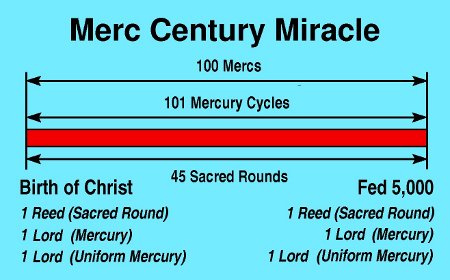 |
Everyone who lives to be two weeks older than 32 years has such a day in his life. Let us call that day their "Merc Century Day" because it repeats their birthday on so many sacred calendars.
Sat 17 Apr 32 was the Merc Century Day for Jesus. He was born on 1 Reed (SR), 1 Lord (M) and 1 Lord (UM). That Saturday, which is being proposed for the date of the miracle of Feeding the 5,000, was also 1 Reed (SR), 1 Lord (M) and 1 Lord (UM). So those last three holy days that fell on that day were a once-in-a-life time anniversary for Jesus.
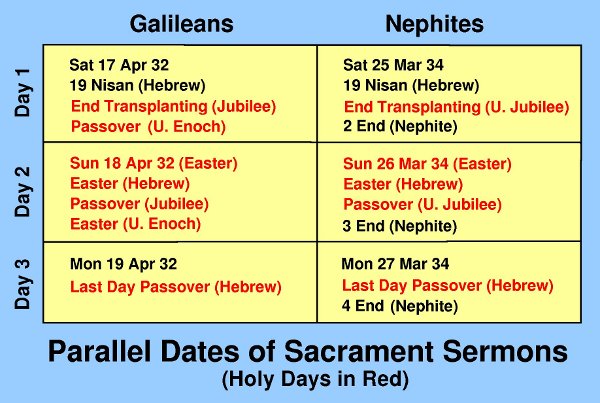 |
Finally, the third day Monday was the Last Day of Passover on the Hebrew Calendar, just as it was for the Nephites. The 7-day Passover can begin on any of four days of the week, but in AD 32 and AD 34 it began on Tuesday both years. So that is another calendar alignment. Table 2 summarizes these calendar alignments between the different days of these events.
Thus it is proposed that the these multiple witnesses testify that the date of the Miracle of Feeding the 5,000 occurred on Sat 17 Apr 32, and the Sermon on the Sacrament followed the next day on Easter Sunday, 18 Apr 32.
Parallels are drawn between the miraculous appearance of the resurrected Jesus Christ to the Nephites and the miraculous feeding of the 5,000 for the Galileans. In particular, on the day after both of those miracles Jesus gave a sermon on the Sacrament of the Lord's Supper. When seeking the date of the Nephite appearance, it is pointed out that Mormon says that it occurred at the "end" of the thirty-fourth year of Christ. In the Nephite Calendar proposed a decade ago there are five days at the end of the year which are actually named "End". Easter Sunday, the most logical day to introduce the Sacrament fell within those five days that year. Thus it is proposed that the second day of Christ's 3-day visit to the Nephites occurred on Easter Sunday, 26 Mar AD 34. Moreover, it turns out that Easter Sunday, 18 Apr AD 32, was calendrically a very similar day. That day is proposed as the day on which Jesus introduced the sacrament to the Galileans on the day following the feeding of the 5,000. Both sacrament sermons testify to divine appreciation of sacred calendar symbolism and teaching about ordinances on the appropriate day.